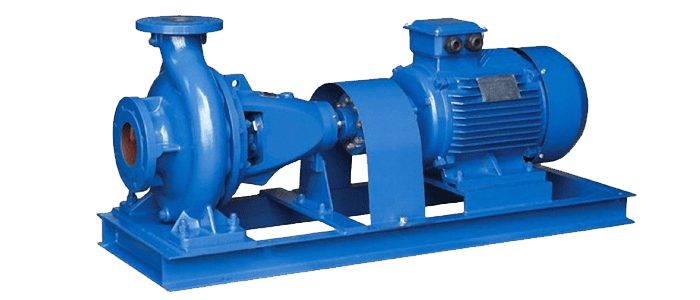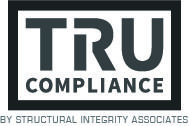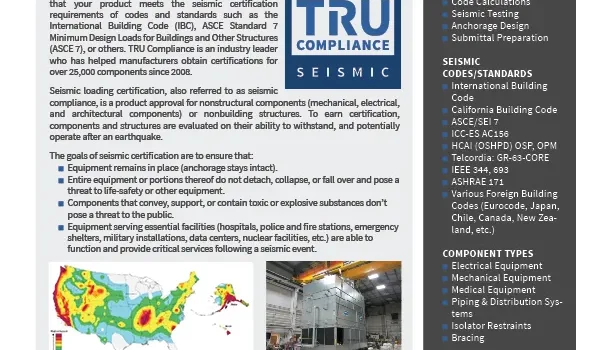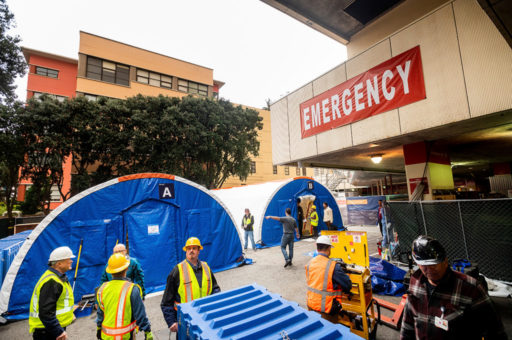This brochure features an overview of TRU Compliance Seismic Certification. Download: TRU Seismic Certification

The Impact of the ASCE 7-16 Standard on Seismic Design & Certification of Equipment
Things change, that’s just a fact of life. But when it comes to engineering codes and standards, change can be confusing, frustrating and expensive. As it relates to seismic design and certification of equipment, it is beneficial to understand the impact of code changes early to begin incorporating requirements in new equipment design, product updates and in the certification process.
One of the main structural design codes used in the United States and abroad, American Society of Civil Engineering (ASCE) 7, undergoes revisions on a five-year cycle. These revisions are based on input from committee members, building officials, interested parties and academia with the goal of ensuring specific performance objectives are achieved as well as incorporating lessons learned from practice. With the increase in enforcement of seismic certification provisions over the past 10 years, there has been a noticeable increase in industry lessons learned. The updates to the seismic provisions in ASCE 7-16 relating to equipment design and certification can primarily be attributed to these lessons learned.
Limitations on RP Used in Certification by Analysis
In the past, no guidance has been provided within ASCE 7 on proper analytical approaches to certify electrical and mechanical components. This has led many Certification Agencies and engineers to certify components through elastic analysis using seismic forces reduced by the component response modification factor (RP). While these RP values may provide reasonable seismic forces for anchorage design, there lacks a robust justification for these values when considering component performance objectives.
Industry experience with shake table testing components designed with these RP values has shown these components do not always maintain structural integrity. A review of past testing by TRU Compliance (Structural Integrity’s Product Certification Agency) has shown that structural elements may be ok, but their connections may suffer premature failure. Unlike provisions for seismic design of buildings, ASCE 7 requirements for nonstructural components do not specify detailing requirements for connections in the lateral force resisting system (such as designing for overstrength forces). As such, members and their connections can be designed for the same loads. This can result in a condition where seismic mechanisms assumed in design using high RP values cannot form due to premature connection failure.
As opposed to implementing material and system specific detailing requirements, which would be unrealistic given the extensive range of component types in practice, ASCE 7-16 includes provisions that require components certified by analysis to remain essentially elastic. The goal is to address premature connection failures by requiring the entire system to be designed for unreduced seismic forces, but this change may also result in the need for more material in the lateral force resisting system (and therefore more cost in the component). This code change can result in substantially higher design forces when certifying a component by analysis and may require extensive design changes to resist the same site demand as a previous certification by analysis (or alternatively derating a component capacity under ASCE 7-16).
Definition of Rugged Component
Manufacturers and consulting engineers alike have looked to use a provision within Section 13.2.2 of ASCE 7 to bypass the need to analyze or test certain components. The provision states that if a component can be shown to be inherently rugged, it can be deemed to meet seismic certification requirements without further consideration. However, there has never been a formal definition of rugged within ASCE 7 and no listing of components that are commonly considered rugged. Therefore, while the provision sounds like a useful option, it was rarely used in cases with building official review.
To the excitement of many, a formal definition of “component, rugged” has been added within ASCE 7-16. However, upon reading the definition one will quickly realize that the definition of a rugged component basically requires the component be certified by experience data. That is, for a component to be considered rugged it must be shown to function based on past earthquake data or past seismic testing. While this is not a major windfall for manufacturers, it is consistent with the approach that has been taken by TRU Compliance, Structural Integrity’s wholly owned subsidiary, and certification arm.
While ASCE 7-16 is essentially requiring experience data certification of rugged components, one aspect of the definition that will likely be pushed extensively by manufacturers is the last sentence which provides “common examples of rugged components.” These examples include AC motors, compressors, and base-mounted horizontal pumps. TRU Compliance agrees that these types of components have historically met performance objectives after high levels of seismic testing, but the specific component proposed to be certified as rugged must be evaluated against the baseline for similar strength and stiffness.
Design Requirements for Modular Systems
The TRU Compliance team has worked on a variety of projects involving modular mechanical and electrical systems for conventional and critical facilities. An example of such a modular system is a modular central plant in which numerous components (chillers, boilers, pumps, piping, electrical distribution, etc.) are installed in factory-built modules are deployed to a site. One of the most common approaches manufacturers attempt to pursue is to classify the entire system as a component per Chapter 13 of ASCE 7 and thereby argue no design of the system is required. In doing so, seismic design requirements are more lenient and anchorage and bracing of internals would not be required if the component importance factor was 1.0.
The intent of the building code was not to allow the use of modular
construction to build to reduced seismic requirements. Systems are normally designed as buildings or structures should still be designed as such when built in a modular fashion. To provide explicit direction, a new section was added to ASCE 7-16 which specifically addresses seismic design of modular mechanical and electrical systems. This section clarifies modular mechanical and electrical systems in excess of 6 feet tall, contain or support mechanical and electrical components must be designed in accordance with the provisions for nonbuilding structures in Chapter 15.
TRU Compliance has understood the intent of the building code and has been designing modular systems in accordance with these provisions for many years. We have expertise in working with manufacturers and developing system designs that comply with code requirements in a buildable and efficient manner.
Allowable Use of AHRI Seismic Certification Standard
Years back, the Air-Conditioning, Heating, and Refrigeration Institute (AHRI) developed a seismic certification standard, ANSI/AHRI Standard 1270/1271, with the intent of clarifying performance objectives and certification requirements specific to HVACR equipment. Much of the document references requirements from ICC-ES AC156 testing standard as well as items from ASCE 7, but provided further clarification of specific items requiring testing and methods of certification.
The ASCE 7 task committee on nonstructural components reviewed this standard and worked with AHRI to ensure there was alignment between code requirements and the AHRI standard. After it was determined the intentions of ASCE 7 and AHRI 1270/1271 were aligned, the standard was incorporated by reference into ASCE 7-16 with a few clarifying points. These clarifications included the assertion that all active and/or energized components must be shake table tested or certified using experience data, a component classified as rugged must comply with the definition in ASCE 7-16 and analysis shall be based on ASCE 7-16 provisions including material specification and requirements for the component to remain essentially elastic.
It is the hope more industry groups will develop detailed seismic certification standards that address items specific to their equipment types. The AHRI standard helps define requirements specific to HVACR equipment to ensure consistency in certification approaches across multiple manufacturers and product certification agencies. More industry engagement is needed to develop such product type standards but will be a great step forward in advancing the certification industry.
Ultimately, updates to codes such as ASCE 7 are intended to align building code performance objectives with practice. The many lessons learned over the past decade of seismic certification have helped further the development of codes and standards that ensure equipment meets specified performance requirements after a design earthquake. For many years, TRU Compliance has been heavily engaged in the code development process and looks forward to continuing to assist our clients to meet product certification requirements in an efficient and cost-effective manner.
This article was originally written for Volume 44, News & Views.





